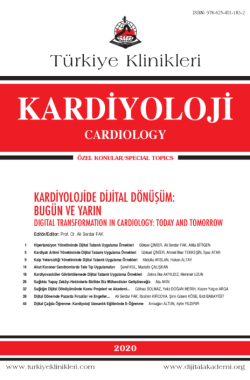Tele Medicine Applications in Acute Coronary Syndromes
Şeref KULa, Mustafa ÇALIŞKANa
aİstanbul Medeniyet Üniversitesi Göztepe Eğitim ve Araştırma Hastanesi, Kardiyoloji ABD, İstanbul, TÜRKİYE
Kul Ş, Çalışkan M. Akut koroner sendromlarda tele tıp uygulamaları Fak AS, editör. Kardiyolojide Dijital Dönüşüm: Bugün ve Yarın. 1. Baskı. Ankara: Türkiye Klinikleri; 2020. p.14-7.
ABSTRACT
Advances in technology have had a positive impact on modern medicine, one of which is telemedicine applications. Early initiation of treatment in acute coronary syndromes (ACS) reduces mortality. Electrocardiography (ECG) knowledge of the healthcare team who sees the patient outside the hospital may not always be sufficient. Therefore, sending the ECG and clinical clinical data in emergent cases to the specialist center, by means of telemedicine applications, even today only via smartphone and internet, both facilitates the work of the healthcare team and provides mortality benefit for the patient by obtaining the tratment earlier. In this article, the use of telemedicine in ACS, related, clinical studies and the way in which the healthcare team who first evaluated the patient in the field should follow will be discussed.
Keywords: Acute coronary syndrome; tele-medicine; smartphone
Kaynak Göster
Referanslar
- S. Scalvini, F. Glisenti, Centenary of tele-electrocardiography and telephonocardiographywhere are we today? J. Telemed. Telecare 2005;11:325-30. [Crossref] [PubMed]
- Scholz KH, Maier SKG, Maier LS, Lengenfelder B, Jacobshagen C, Jung J, et al. Impact of treatment delay on mortality in ST-segment elevation myocardial infarction (STEMI) patients presenting with and without haemodynamic instability: Results from the German prospective, multicentre FITT-STEMI trial. Eur Heart J 2018;39:1065-74. [Crossref] [PubMed] [PMC]
- Maynard C, Althouse R, olsufka M, Ritchie JL, Davis KB, Kennedy JW. Early versus late hospital arrival for acute myocardial infarction in the Western Washington thrombolytic therapy trials. Am J Cardiol. 1989;63:1296-300 [Crossref] [PubMed]
- Ibanez B, James S, Agewall S, Antunes MJ, Bucciarelli-Ducci C, Bueno H, et al. ESC Scientific Document Group. 2017 ESC Guidelines for the management of acute myocardial infarction in patients presenting with STsegment elevation: The Task Force for the management of acute myocardial infarction in patients presenting with ST-segment elevation of the European Society of Cardiology (ESC). Eur Heart J. 2018;39:119-77. [Crossref] [PubMed]
- Squire BT, Tamayo-Sarver JH, Rashi p, Koenig W, Niemann JT. Effect of prehospital cardiac catheterization lab activation on doorto-balloon time, mortality, and false-positive activation. prehosp Emerg Care 2014;18(1): 1-8. [Crossref] [PubMed]
- Karagounis L, Ipsen SK, Jessop MR, Gilmore KM, valenti DA, Jeffrey J, et al. Anderson. Impact of Field-Transmitted Electrocardiography on Time to In-Hospital Thrombolytic Therapy in Acute Myocardial Infarction. Am J Cardiol 1990;66:786-91 [Crossref] [PubMed]
- Diercks DB, Kontos MC, Chen AY, pollack Cv Jr, Wiviott SD, Rumsfeld JS, et al. Utilization and impact of pre-hospital electrocardiograms for patients with acute ST-segment elevation myocardial infarction: data from the NCDR (National Cardiovascular Data Registry) ACTIoN (Acute Coronary Treatment and Intervention outcomes Network) Registry. J Am Coll Cardiol. 2009;53(2):161-6. [Crossref] [PubMed]
- Maciel ALA, Irigoyen MC, Goldmeier S. Diagnostic Accuracy of prehospital TeleElectrocardiography in Acute Coronary Syndrome. Telemed J E Health. 2019;25(3):199- 204. [Crossref] [PubMed]
- Brunetti ND, De Gennaro L, Amodio G, Dellegrottaglie G, pellegrino pL, Di Biase M, et al. Telecardiology improves quality of diagnosis and reduces delay to treatment in elderly patients with acute myocardial infarction and atypical presentation. Eur J Cardiovasc prev Rehabil. 2010;17(6):615-20. [Crossref] [PubMed]
- Rasmussen MB, Frost L, Stengaard C, Brorholt-petersen JU, Dodt KK, Søndergaard HM, et al. Diagnostic performance and system delay using telemedicine for prehospital diagnosis in triaging and treatment of STEMI. Heart. 2014;100(9):711-5. [Crossref] [PubMed]
- Chauhan v, Negi pC, Raina S, Raina S, Bhatnagar M, Guleri R, et al. Smartphone-based tele-electrocardiography support for primary care physicians reduces the pain-to-treatment time in acute coronary syndrome. J Telemed Telecare. 2018;24(8):540-546. [Crossref] [PubMed]
- Roffi M, patrono C, Collet Jp, Mueller C, valgimigli M, Andreotti F, et al; ESC Scientific Document Group. 2015 ESC Guidelines for the management of acute coronary syndromes in patients presenting without persistent ST-segment elevation: Task Force for the Management of Acute Coronary Syndromes in patients presenting without persistent STSegment Elevation of the European Society of Cardiology (ESC). Eur Heart J. 2016;37(3):267-315. [Crossref] [PubMed]
- oliveira MT Jr, paula LJ, Marcolino MS, Canesin MF. Executive summary - guideline on telecardiology in the care of patients with acute coronary syndrome and other cardiac diseases. Arq Bras Cardiol. 2015;105(2):105- 11. [Crossref]
- Brunetti ND, Scalvini S, Acquistapace F, parati G, volterrani M, Fedele F, et al. Telemedicine for cardiovascular disease continuum: A position paper from the Italian Society of Cardiology Working Group on Telecardiology and Informatics. Int J Cardiol. 2015;184:452-8. [Crossref] [PubMed]
- Caldarola p, Gulizia MM, Gabrielli D, Sicuro M, De Gennaro L, Giammaria M, et al. ANMCo/SIT Consensus Document: telemedicine for cardiovascular emergency networks. Eur Heart J Suppl. 2017;19(Suppl D):D229- D43. [Crossref] [PubMed] [PMC]
- Marcolino MS, Maia LM, oliveira JAQ, Melo LDR, pereira BLD, Andrade-Junior DF, et al. Impact of telemedicine interventions on mortality in patients with acute myocardial infarction: a systematic review and meta-analysis. Heart. 2019;105(19):1479-86. [Crossref] [PubMed]

